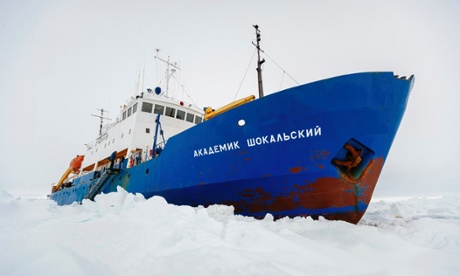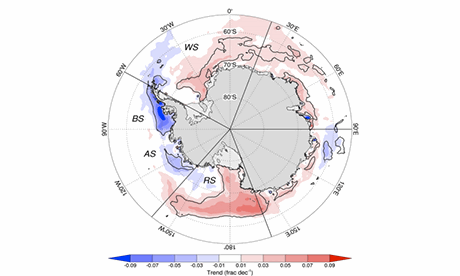Research ship trapped in Antarctic ice because of weather, not climate change.

The trapped Russian ship Akademik Shokalskiy, in Antarctica. Photograph: Andrew Peacock/AP
The predicament and subsequent rescue of 52 passengers – both tourists and scientists – on the Russian ship Academik Shokalskiy has gripped media around the world. The smooth rescue was impressive and a great relief, although the vessel itself and its crew are still stuck – and now one of the icebreakers sent to help in the rescue, the Chinese ship Xue Long, is itself stuck in the ice.
Some commentators have remarked on what they describe as the 'irony' of researchers studying the impact of a warming planet themselves being impeded by heavy ice. With some even suggesting that the situation is itself evidence that global warming is exaggerated.
In fact, the local weather patterns that brought about the rapid build up of ice that trapped the Academik Shokalskiy tell us very little about global warming. This is weather, not climate.
Regionally, climate change can vary markedly across the Earth so to detect human influences on the climate system climate scientists must consider the Earth as a whole.
What is clear is that the impact of climate change on ice at both poles is complex.
In the area where the Akademik Shokalskiy is trapped there has been an increase in sea ice extent for the year as a whole since the late 1970s, although not for the month of December (see attached graph). The amount of ice in the area can vary considerably from year to year making ship operations difficult. The December ice extent in 2011 and 2012 was much larger than the long-term mean, and the ice in 2013 has obviously been of comparable magnitude.
We have relatively short records of the extent of sea ice across the polar regions and can only accurately examine trends since sophisticated microwave instruments became available on the polar orbiting satellites in the late 1970s. However, the records do show that since that time the two polar regions have experienced very different trends in ice extent. Arctic sea ice has been declining in extent in every month of the year, but with the maximum loss of almost 14% per decade being found in September. In contrast, sea ice extent around the Antarctic has increased in every month of the year with the largest increase being almost 4% per decade in March. The contrasting nature of the changes was highlighted in September 2012 when both polar regions experienced new record extents of sea ice for the satellite era. On 16 September the Arctic sea ice extent reached a new minimum level of 3.41m sq km, beating the previous record minimum that occurred in 2007. However, in the Antarctic there was a new record maximum extent of 19.72m sq km on 24 September, exceeding the previous record of 19.59m sq km, which occurred on 24 September 2006. In September 2013 there was even more sea ice across the Southern Ocean, beating the 2012 record.
 The trend in annual mean sea ice concentration in Antarctica for 1979 – 2012. The bold line highlights areas where the trend is significant at
The trend in annual mean sea ice concentration in Antarctica for 1979 – 2012. The bold line highlights areas where the trend is significant at The reasons for the trends in sea ice are still being debated. However, for the Arctic it is estimated that anthropogenic forcing through the emission of greenhouse gases has contributed 50–60% of the long-term decline of Arctic sea ice. The remaining contribution is believed to come from natural variability. But in the Antarctic the reason for the increase in ice is less clear. The pattern of sea ice change around the Antarctic is dominated by a decrease to the west of the Antarctic Peninsula and an increase across the Ross Sea, which can be attributed to more storm activity between these two areas. The extent of sea ice is strongly influenced by the strength and direction of the winds and the increase in storms has given more warm, northerly flow over the Bellingshausen Sea and greater cold, southerlies over the Ross Sea. This pattern of change is consistent with the increasing temperatures observed over the Antarctic Peninsula and west Antarctica, where temperatures have risen as much as anywhere in the southern hemisphere.
It's currently not clear why there has been an increase in the number and intensity of storms over the southern South Pacific since the late 1970s. However, this area is where the ozone hole has a large impact on the atmospheric circulation and where signals of the El Nino-Southern Oscillation, one of the largest climatic cycles on Earth, are felt most in the Antarctic. It's also where the greatest natural variability in atmospheric circulation is observed in the southern hemisphere, which has been attributed to the fact that the large Antarctic ice sheet is displaced slightly from the pole.
Sea ice extent has a large natural variability in both polar regions because of the amplifying effect of interactions between the atmosphere, ocean and sea ice. In the Arctic there is now increasing evidence that rising greenhouse gas emissions are playing a significant part in the loss of sea ice. However, in the Antarctic the increase in annual mean sea ice extent is only just over 1% per decade, making it impossible at present to separate natural variability from any human influence.
• Prof John Turner is leader of the Climate Variability and Modelling project at the British Antarctic Survey